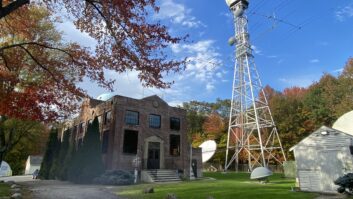Basic rules covering the terrestrial digital radio service now have been spelled out by the FCC, and AM IBOC at night has been allowed.
But future iterations of digital operation are just beginning to be examined. And the commission has tacked onto a new digital radio proceeding several broader topics under the umbrella of “public service obligations.”
Some questions — like possible spectrum fees on digital subscription services and tightening of rules governing automated broadcast operations for all stations — are controversial and could have great impact at the station level beyond the digital conversion rollout.
At least one idea under scrutiny could make operations easier for small stations by allowing public files to be kept online, experts believe.
The commission on May 31 released details of its digital radio rules. The text expanded on its vote in March that gave regulatory certainty to HD Radio operators, codified multicasting and allowed AM HD stations to turn on digital at night.
The agency calls these the final operational requirements and related licensing and service rule changes for terrestrial digital radio. The 74-page document released contains details many IBOC proponents and stations have been seeking for some time. The changes were to take effect 30 days after publication in the Federal Register. That had not occurred as of early June.
At the same time, the text touched on numerous questions that are likely to shape future debate. In the document, the commission makes clear that many decisions remain undecided.
For instance, in a Second Further Notice of Proposed Rulemaking, the commission asks whether it should limit the subscription channels a station may air, such as to 20–25 percent of a station’s digital capacity. That FCC estimate is based on current FM SCA use.
The agency is asking whether such a limit on “conditional access” ensures that free portions of a station’s digital channel are not compromised. The agency is also asking whether noncoms be treated differently in this.
Spectrum fees may someday be applied to subscription services for digital radio. Congress already has authorized the agency to require DTV stations to pay a fee of 5 percent of gross revenues from so-called “feeable” ancillary digital radio services; the FCC now is asking if it’s appropriate to require the same of radio.
(Not mentioned in the text is that any commission spectrum fees would be separate from Ibiquity Digital’s fee for supplemental audio, which according to a licensing fact sheet on the company’s Web site is 3 percent of net revenue derived from any supplemental audio service, with a $1,000 minimum per channel.)
Comments on the Second Further Notice of Proposed Rulemaking, FCC 07-33, are due 60 days after Federal Register publication.
WHAT IT DID
Here’s a summary of what the commission did, including observations it offered in its text and summaries it provided of comments it had received for and against various issues.
Legal ID
The commission said station ID requirements are necessary for digital stations and laid out regulations.
Opinions had differed as to whether separate call signs should be required for digital and/or multicast channels, according to the commission.
Public interest groups favored expanding the call letter system so listeners could more easily identify the source of programming. Ibiquity opposed this, arguing there’s no need for additional ID requirements because IBOC stations that don’t multicast are airing identical programming. Ibiquity also asserts that broadcasting a separate digital call sign would require “significant system and equipment modifications.”
Small businesses, including stations and small manufacturers, opposed requiring IDs for multicast stations because, they say, stations voluntarily identify their channel positions to cultivate market recognition. Additionally, they argued, digital station calls can be embedded into the digital bit stream, so the FCC can have an easy way to identify a station for enforcement purposes.
In the new rules, the FCC said digital AMs and FMs must make station identification announcements at the beginning and end of each time of operation, as well as hourly, for each programming stream.
Proper identification, it said, consists of the call letters followed by the program stream, and then the community of license, according to the commission. Presumably this would suffice: “This is WXYZ, HD3, Anytown, USA.” Stations may insert between the call letters and the station’s community of license the frequency, channel number, name of the licensee and/or the name of the network, at their discretion. The commission didn’t give examples for main-channel digital FMs.
Third, a station operating in DAB hybrid mode must identify its digital signal, including any free multicast audio programming streams, in a manner that appropriately alerts its audience to the fact that it is listening to a digital audio broadcast. This requirement can be met orally on-air or by text messages on the receiver display.
AM Nighttime Operation
“On balance, we find the benefits of full-time IBOC operation by AM stations outweigh the slightly increased risk of interference,” the commission states in the text.
The approval ended a long period of speculation as to when the FCC would allow AMs to broadcast digital signals at night. Some IBOC opponents believe widespread adoption will bring significant degradation to the AM band at night.
But studies conducted by Ibiquity and analyzed by NAB indicate the greatest potential for interference is at the fringe of coverage areas, “primarily where substantial interference from analog” already exists, the agency states in the text.
As we’ve reported, those AMs already transmitting in IBOC during the day can go on at night without additional FCC notification. The FCC will presume notifications it receives from AMs after these changes take effect will be for both day and night IBOC operation.
No Mandate
The FCC said it won’t establish a deadline for stations to begin conversions to digital. Radio licensees are under no statutory mandate to convert and a hard deadline is “unnecessary,” given that DAB does not require the allocation of additional spectrum, it stated.
Extended Hybrid Mode
The extended hybrid mode, which adds up to 50 kbps of data carrying capacity to an FM IBOC signal, “holds great promise,” the commission stated.
It cited an NPR report that concluded FM extended hybrid mode does not affect host analog reception in a variety of radios. The research “provides ample basis for permitting such operations.” The agency is confident its staff can work out any interference issues with this operation on a case-by-case basis “in a timely fashion.”
Multicasting
FMs can multicast without “additional” FCC approval. The FCC document specifically stated that stations are “strongly encouraged,” though not required, to use their extra channels for public affairs programming and formats that serve minorities, underserved populations and non-English-speaking listeners.
Broadcast owner Mt. Wilson Broadcasters opposed multicasting in its comments to the FCC, saying that splitting the channel would impair FM service. NPR replied that Mt. Wilson was “misinformed” about the purpose of IBOC and the feasibility of multicasting. The FCC found that multicasting will not degrade the FM band.
As AM IBOC operations progress, Ibiquity told the FCC, it intends to introduce the multicasting concept for AM stations.
Time Brokering, Ownership and Attribution
Time brokering is permitted on digital channels. The FCC now allows what are essentially leasing deals for main analog channels, FM subcarriers and excess DTV bandwidth.
The FCC said it agrees with small business that allowing time brokering will allow stations to recoup some of their digital conversion costs as well as providing a way for new entrants to break into radio.
The FCC agreed with a coalition of public interest groups that a licensee which is already at the ownership maximum in a market shouldn’t be allowed to acquire additional broadcast streams through time brokering.
It clarified that, for multicasting, a station owner which programs more than 15 percent of the total weekly hours broadcast on a digital audio stream of another station in the market will be considered to have an attributable interest in the brokered station, which counts toward the local ownership caps.
LPFM
The FCC said if a low-power FM station is technically capable of transmitting a digital signal, there should be no “regulatory impediment” preventing its adoption of IBOC.
Ibiquity says IBOC transmission equipment can operate at the 100 watt power level an LPFM needs, but a 10 watter may be out of luck as such a low power level may make digital broadcasts “unfeasible,” according to the FCC. The commission didn’t state whether there are any LPFMs broadcasting in digital.
Main-Channel Audio Quality
Stations must provide at least one free digital over-the-air service that is “comparable to or better in quality” than the main analog channel. This baseline constraint mirrors a DTV requirement. Stations must still simulcast their analog program on their main digital channel.
The FCC said it may revisit the simulcasting obligation when it decides whether or not to approve the NRSC-5 Standard. In 2005, the NRSC adopted NRSC-5 and submitted the standard to the FCC for evaluation. The commission said it’s in the public interest to adopt policies and rules for IBOC before it has completed evaluating the standard.
Bit Stream Flexibility
NAB argued that, this early in the IBOC transition, it’s impossible to know for sure the number of bits necessary to support a good-quality main digital signal or several multicast channels without degradation. Cox Radio stated that any restrictions adopted now could be soon obsolete.
The FCC declined to require a minimum digital bandwidth level, leaving this at stations’ discretion.
Datacasting
Ibiquity urged the commission to include enough flexibility in its datacasting authorization to promote innovation. NAB said such flexibility will expedite the emergence of IBOC.
Stations can offer any type of data service, consistent with rules applicable to analog SCA services, as long as the new service does not impair “the mandated stream of free audio programming.”
Subscription Services
Subscription services are only allowed if a station has experimental authorization for the service. The agency said it will grant such authorizations for uses that serve the public interest, including current services carried on subcarrier such as radio reading services.
Commenters emphasized the benefits of multiple digital audio channels and how that would ensure the continuing viability of radio reading services as well as enhance broadcasters’ ability to offer more niche programming and public affairs broadcasts.
Dual FM Antennas
Stations may use separate antennas for the analog and digital signals without an STA request, subject to criteria contained in a Dual Antennas notice issued in early 2004.
Notification Procedures
To allow stations to take advantage of technical improvements as they develop, rather than waiting for commission action and new rules, the FCC gave its Media Bureau expanded authority to act on IBOC rules. After appropriate notice and public comment, it can implement new notification procedures to cover new IBOC configurations.
Public Interest Obligations & EAS
The FCC is applying these requirements to all free over-the-air IBOC channels (both digital main channels and multicast): Political broadcasting; payment disclosure; prohibited contest practices; sponsorship identification; cigarette advertising; and broadcast of taped or recorded material.
Digital stations must air all national EAS messages on all audio streams. Participation in state and local level alerts, while encouraged, is voluntary. Stations choosing to comply with EAS must comply with Part 11 EAS rules.
Periodic Reviews
The commission said it will conduct periodic reviews of digital service and receiver penetration as circumstances warrant. It will issue an annual report on how the new digital services are rolled out, including what services are offered on multicast streams.
Kahn, Others Kicked to the Curb
The FCC dismissed Petitions for Reconsideration from The Amherst Alliance, Glen Clark and Associates, and Leonard Kahn.
After the FCC declared IBOC was the system for the United States, Amherst sought a new rulemaking on digital radio and asked the commission to establish a test for the Eureka-147 system. The commission now said it would not delay the IBOC proceeding.
Clark had challenged the FCC’s daytime-only restrictions for digital AMs, offering criteria to identify those that could broadcast at night with minimal risk of interference. Given the recent approval of AM nighttime operations, the agency dismissed his petition as moot.
Kahn’s request for the commission to stay implementing IBOC until the agency revises how it evaluates new technology was dismissed for being untimely filed. Kahn provided no justification for the late timing, according to the FCC.
WHAT IT DIDN’T DO
In issuing its text, the FCC also deferred action on a number of issues.
Analog Protection
Ibiquity told the commission that in the early portion of the transition, the FCC should protect analog signals, such as by limiting the power level and bandwidth occupancy of the digital carriers in the hybrid mode. At some point, when digital receiver penetration warrants, the agency could reverse this protection to protect digital operations.
The agency said it’s too soon in the conversion to consider this action, which could have “unknown and unintended consequences.”
All-Digital Mode
Given that there are no technical standards, it’s too soon in the conversion to consider handing down rules for all-digital operations and allow stations to turn off their analog signals, the FCC found.
“Our principle focus at this stage is to ensure that the ground rules are set for the introduction of hybrid IBOC DAB.” Broadcasters were encouraged to experiment with all-digital mode with appropriate authorization.
Digital Rights Management
The commission had asked whether the transmission of free non-encrypted digital signals could lead to the “indiscriminate recording and Internet distribution” of copyrighted music and how this could be prevented.
It stated that interested parties are seeking a solution and deferred action on this issue. NAB, CEA, Ibiquity, satellite radio and the Recording Industry Association and other affected parties are discussing the issue and also lobbying Congress. Lawmakers have said they prefer that industry settle the matter without government intervention.
Radio Reading Services
IBOC transmission or receive equipment is not required to have RRS capabilities at this time, but the commission said this could be addressed in the future. The International Association of Audio Information Services had urged the FCC to require digital stations to carry RRS, arguing that before any station offers income-generating secondary audio streams, it should be required to first provide digital bandwidth for RRS.
Ibiquity opposed mandatory RRS receiver capability, saying this would hamper the rollout at this stage and burden manufacturers with higher costs. NPR said it’s inappropriate to consider mandating RRS at this stage in the digital conversion because there needs to be more testing of digital RRS.
The FCC, which does not require analog stations to carry reading services, said it encourages voluntary cooperation toward digital radios being able to decode RRS signals. The agency declined to impose a digital RRS requirement and it said this would be addressed in a DAB periodic review later.
Super-Powered FMs & Short-Spaced Stations
Livingston Radio had urged the agency to restrict digital power levels for super-powered FMs, saying they can cause more interference than stations that comply with class limits. Cox Radio and Bonneville asserted that this was beyond the scope of the proceeding. The FCC agreed and declined to adopt special restrictions on both super-powered FMs and short-spaced stations.
The power and antenna height combination of a super-powered FM station exceeds FCC class limits. Such stations were authorized before the current class limits were adopted and have “grandfathered” status.
Translators and Boosters
Digital translators and boosters are permitted during interim IBOC operations, but the commission said it needs a stronger record to address technical issues with their authorization before adopting permanent rules.
Noncoms
NPR, the FCC stated, pressed it for flexibility in how noncoms use their digital bandwidth; NPR does not expect to see “a profusion of commercial service offerings” by noncoms and expects any subscription or other services provided to relate to the noncom mission. Public interest groups believe NCEs should use most of their digital bandwidth for non-profit, non-commercial services. The FCC is not making a decision yet but is seeking comment on this issue.
TV Channel 6
The FCC agrees with NPR that the low power increase from an IBOC signal probably won’t increase interference to analog TV Channel 6 stations and that the DTV transition may make this issue moot. Therefore, no changes governing TV Channel 6 protection are necessary at this time, the FCC said. It intends to open a separate proceeding on the issue.
Comment on this or any article. Write to [email protected].




